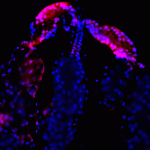Link to Pubmed [PMID] – 17027843
Insect Biochem. Mol. Biol. 2006 Oct;36(10):769-78
We have performed a global genome expression analysis of mosquito responses to CM-25 Sephadex beads and identified 27 regulated immune genes, including several anti-Plasmodium factors and other components with likely roles in melanization. Silencing of two bead injection responsive genes, TEP1 and LRIM1, which encode proteins known to mediate Plasmodium killing, significantly compromised the ability to melanize the beads. In contrast, silencing of two Plasmodium protective c-type lectins, CTL4 and CTLMA2, did not affect bead melanization. This data suggest that the anti-Plasmodium factors have dual functions, as determinants of both Plasmodium killing and melanization of the parasite and other foreign bodies, while the Plasmodium protective factors are specifically utilized by the parasite for evasion of mosquito defense mechanisms.

